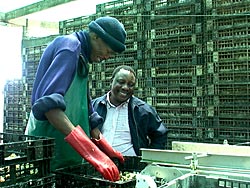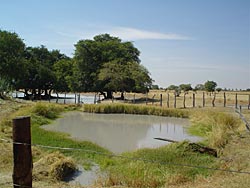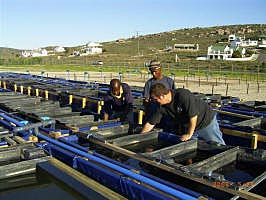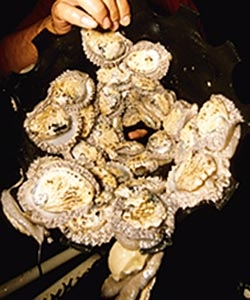| |
|
 |
|
Aquaculture: Existing aquaculture activities |
Freshwater aquaculture is mainly seen as a potential source of food security, and is mainly targeted at rural communities in coastal areas. Mariculture (marine aquaculture), on the other hand, is capital and technological intensive, and is seen as a source of high value fishery products for export. In this section we explore some of the aquaculture potential and existing projects in Angola (English or Portuguese), Namibia and South Africa. If you know of more initiatives, especially community initiatives, please write to the DLIST team.
 Angola Angola
Angola is endowed with both inland and marine aquatic resources suitable for aquaculture. Infrastructure and institutional capacity are the two primary constraints to the development of aquaculture in Angola. In this country, there are a few Tilapia operations inland. Tilapia is a common fish species that is known to be suited for aquaculture, for the fact that it effectively consumes low quality feeds and animal manure.
Aquaculture in Angola is considered one of the priorities of the Angolan Government to promote sustainable economic development and contribute to poverty reduction. While it helps to provide food security, the expansion of aquaculture is also aimed at the sustainable replenishment of aquatic biological resources and at preventing non-sustainable fishing in the country.
The Ministry of Fisheries launched in 2007 a publication on aquaculture in Angola (State of Aquaculture in Angola). In this section we summarise the overview of aquaculture in Angola presented in this publication, which has kindly been sent to DLIST by the Institute for Development of Artisanal Fisheries and Aquaculture (IPA). For more information please visit the website of the Ministry of Fisheries or contact the Institute for Development of Artisanal Fisheries and Aquaculture (IPA).
Is there aquaculture in Angola?
Aquaculture has started in Angola before independence, in a rudimentary manner and through private initiative. However, war has created difficulties of access to provinces, and this activity has decreased. Only recently has there been renewed interest from the private sector.
Aquaculture in Angola is divided into mariculture and inland aquaculture. Mariculture includes the culture of shellfish, crustaceans, fish, and algae in the coastal zone. Inland aquaculture is the most lucrative and widely used practice, and it is practised in artificial lagoons, cement tanks or earth ponds, and, in small scale, in cages.
Potential in the country
Studies have confirmed the existence of excellent conditions for the development of aquaculture in the country (in terms of temperature and water resources, as well as in terms of fish consumption habits). A survey of inland and coastal water bodies has recently been carried out, confirming the country’s high hydro potential for the development of aquaculture.
The country is rich in tilapia, catfish and other species, which can be cultivated to increase production. The selection of native species that are adequate for farming is of paramount importance due to restrictions in aquatic species imports, with a view to safeguarding native fauna and flora, protecting habitats and preventing the introduction of animals, plants and diseases.
The presence of large lagoons, lakes and dams provides the possibility of practising fish farming in cages, which does not require large bodies of water nor high execution costs.
Recent research has recommended the construction of Larviculture Centres that can produce larvae of native species of fish, with a view to producing young fish of economic and ecological importance that can be used in populating and repopulating rivers, lagoons, dams and water reservoirs, and can be provided to rural producers for community farming.
Inland aquaculture: In some inland aquaculture facilities, it is possible to create hydro improvement systems that can be used to water farms and pastures (as a basis for livestock raising). Another potential practice identified is agro-aquaculture (aquaculture integrated with domestic animal raising).
Mariculture: The Angolan coast’s potential is extensive and favourable for mariculture. The areas of interest for mariculture include lagoons and mangroves. Small areas adjacent to lagoons are adequate for marine species farming, especially prawns. As the Angolan coast does not have nooks or bays extending deeply into the interior of the continent, it has been suggested that three sites in the provinces of Luanda and Benguela, where all the necessary conditions have been found, be used for culture experiments.
The coastal prawn and the lobster are among the native species of crustaceans in Angola with potential for mariculture. Oysters and mussels are species of commercial bivalve molluscs that can be used in mariculture in Angola. The culture of mussels has been tested in Angola with very promising results, thought it has not been commercialised yet and its potential market is unknown. Mussels, such as oysters, can be incorporated in the biological treatment systems of prawn cultures, yet they are less tolerant to fluctuations in salinity. There are also species of fish, such as sole, that can be used.
 Current state Current state
In 2003 the Ministry of Fisheries launched a programme for the development of aquiculture. There are currently some activities, especially of inland aquaculture, while at the same time research is being carried out by teams of national and international experts and pilot projects implemented in several areas. In some provinces, communities of fishers have organise themselves into cooperatives and associations.
Aquaculture: There are currently aquaculture activities in the provinces of Cabinda, Luanda, Bengo and Moxico. There seems to be some tendency to import exotic species from neighbour countries.
In Cabinda province, both conflicts with the oil industry (restrictions on fishing areas, oil spills, etc) and the proximity of the Democratic Republic of Congo, where there is tradition of aquaculture, have led to increasing interest in community fish aquaculture activities. Fish farming in this province has been developing in an empirical manner and through private initiative. Fish farmers practise aquaculture in earth ponds using native species (especially tilapia and catfish).
In Luanda province, a number of private community fish farming activities have been identified. In Bengo province there are fish farming activities both of private initiative and with commercial purposes.
Mariculture: The exploration of the coast for mariculture purposes has been catching the attention of the national and international private sector. Assessment studies have been undertaken and prawn mariculture projects are planned in coastal provinces, in some cases using exotic species.
There are still no appropriate facilities for algae culture in Angola, yet algae production is indispensable in most larviculture facilities. There is no reference to activities of marine fish aquaculture in Angola.
Legal and Institutional Framework
- Progress and Sustainability Strategy for Fisheries and Aquaculture (Ministry of Fisheries, 2004)
- National Aquaculture Policy (Ministry of Fisheries, 2004)
- Land Use Plan for Fisheries and Aquaculture 2006-2010 (Resolution N 9/06)
Training and Research
There are no universities or technical schools in Angola offering aquaculture training. The future Fishing Academy in Namibe, where there are plans for aquaculture as well as fishing training, will be an important centre to make the aquaculture sector in Angola more professional.
2006 saw the beginning of the Basic Fish Aquaculture Training programme, an initiative of IPA. The province of Luanda (municipality of Cacuaco) was the first to benefit from the course. The training programme targets small fish farmers, household farmers and rural extension staff.
IPA is planning the establishment of Aquaculture Research and Development Centres in 7 provinces of the country covering coastal and inland regions (Cabinda, Bengo, Benguela, Namibe, Malange, Moxico and Lunda Norte), in order to provide support to research and extension activities for aquaculture. In the province of Malange, for example, there are plans to build a larviculture centre, an aquaculture school, and to implement a project of fish farming using cages.
 Namibia Namibia
National goals
The Namibian government is challenging the fishing industry to diversify operations from not only catching at sea, but also getting involved with fish farming. It is promoting freshwater aquaculture, which will mainly be a community-based co-operative activity, making use of labour intensive methods. The produce from this industry will be primarily destined to local communities, as well as to local and international markets. Additionally, mariculture projects where high value marine
species are produced will be intended for export markets.
| According to Dr Iyambo, the Minister of Fisheries and Marine Resources… “Namibia is looking forward to the establishment of a vibrant and profitable aquaculture industry by the year 2030” |
According to the Namibian government, a conservative estimate for the development of the industry is a growth in value from the current N$20 million to N$250 million by the year 2009, with direct employment expanding from the current 422 people to 1,640 people. This employment rate only takes into account the labour used directly on the farms.
Current activities
The government’s Ministry of Fisheries and Marine Resources (MFMR) is currently running six pilot-aquaculture farms based on rural community participation in the northern Caprivi and Kavango regions.
The Spanish government has funded an Aquaculture centre that is based in Omahenene, in the Omusati Region. Further to that, as a way of diversifying the economy of Oranjemund in southern Namibia, the Namdeb mining company and the NovaNam fishing company have established a fish farm, for the purpose of preventing the town from becoming a ghost town in case the diamond reserves become exhausted. The fish farm is based in the mine-out seawater ponds, located on the diamond mining company’s main land-based production area.
In the Walvis Bay/Swakopmund area alone, there are a total of four well established Oyster farms with both Pacific oysters (Crassostrea gigas) and European oysters (Ostrea edulis) being grown. The estimated production of the Namibian Oyster industry in 2004 was 6 million Oysters, worth approximately N$12 million.
Mussel farming is being practised in Lüderitz, with the latest addition to this lucrative industry being abalone (Haliotis midae) farming. Abalone farming is at the moment being practised by one farmer. In order for the abalone farming industry to thrive, there will be an increased demand on mainly kelp as well as a few other seaweed species—the feed for the abalones.
 South Africa South Africa
National goals
The South African Government recently announced that it is set to invest R100 million in marine fish farming projects in the financial year 2008/09. These projects will include abalone farms, fin fish farms and a state hatchery. The country lags far behind in international efforts to boost aquaculture further to compensate for devastated wild fish stocks.
| According to the Department of Environmental Affairs and Tourism (DEAT), mariculture is still in its infancy in South Africa, with only 1% of all fish sold commercially that is farmed. Nevertheless, it is considered to be the most established among the three countries of Angola, Namibia and South Africa. |
South Africa’s Department of Fisheries believes that the best potential for the production of aquaculture vests mainly on the production of marine species such as abalone, oysters and mussels; and freshwater species such as trout, catfish, tilapia and ornamental fish. Other species that may be farmed include eels, crayfish, cob, yellow-tail, grunter, tuna and turbot.
Current initiatives
There are two aquaculture initiatives involving local communities presently underway in the West Coast. Nine fishermen have been given the opportunity to set up their own aquaculture mussel farm in Saldanha Bay, called Masiza Mussel Farm Pty Ltd, with some help from Blue Bay Aquafarm, a mussel and oyster-farming company (as mentor) and financial services group ABSA. The company started the empowerment project 4 years ago, to help fishermen who can no longer make a living by going to sea. The people involved in the Masiza Mussel Farm (Pty) Ltd are not only farmers and raft owners, but captains of their own ship, making their own decisions in their own businesses in an informed way. For more details on this initiative you can contact Terrasan Holding and Investment Company on +27 (0)21 930 5023. Read more here.
The majority of mariculture activities are concentrated in the Western Cape Province. Due to the fact that mariculture presents opportunities of alternative livelihood post-mining, the De Beers diamond mining company has shown some interest in mariculture development. De Beers has developed an experimental oyster farm within the Namaqualand mining area. It also works with development institutions to investigate the commercial feasibility of a 100 ton per annum abalone species. A project of this scale would have the potential to provide substantial employment and capacity benefits to the local communities, as well as to stimulate down stream investment and multiplier effects. Read more about De Beers’ mariculture initiatives here.
| According to DEAT…. “An exception to the high coastal land in South Africa is the Northern Cape where some diamond mines are nearing the end of their productive lifespan. These operations will leave infrastructure that in some cases could be converted for marine aquaculture operations” |
 The Camdeboo Satellite Aquaculture Project in the Karoo, Graaff-Reinet, funded by the EU, makes use of existing reservoirs and dams to farm fish. The people to be involved in this project are the unemployed wives of Karoo farm labourers. The EU has already funded the project to the tune of R1 million. The project intends to farm the Tilapia fish (Tilapia mossambicus) which has been dubbed the “Karoo perlemoen”, an indigenous, robust, disease-free, vegetarian and excellent-tasting fish. Find out more on how the project (fish farm) works here. The Camdeboo Satellite Aquaculture Project in the Karoo, Graaff-Reinet, funded by the EU, makes use of existing reservoirs and dams to farm fish. The people to be involved in this project are the unemployed wives of Karoo farm labourers. The EU has already funded the project to the tune of R1 million. The project intends to farm the Tilapia fish (Tilapia mossambicus) which has been dubbed the “Karoo perlemoen”, an indigenous, robust, disease-free, vegetarian and excellent-tasting fish. Find out more on how the project (fish farm) works here.
A Danish-based company UNI Aqua is currently working on what will become South Africa’s biggest land-based fish farming project. This development will take place at the mouth of the Berg River in Velddrif on the Cape’s West Coast. It is expected that once the project has been fully developed, at a cost of some R18 million, it will play a major role in creating jobs in this region’s ailing fishing industry. Read more here.
Lessons can be learned from the freshwater aquaculture business taking place at Lake Kariba, Zimbabwe, where one commercial company, Lake Harvest (Pvt) Ltd., employs 500 people in the production and processing of Tilapia. This farm is currently the largest Tilapia producer in Africa. Read more here.
|
|
|